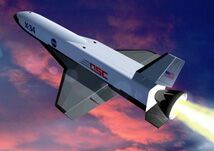| SPACE | TRANSPORT : | Spacecraft Tech : | X-34 |
NASA has tied up with Orbital Sciences Corporation (OSC) to design and develop the X-34 technology demonstrator.The contract is managed by the Marshall Space Flight Center (MSFC). The goal of the X-34 program is to demonstrate "key technologies" to complement their Reusable Lanuch Vehicle program.
|
|
Stats | |
|---|---|---|
| Length : | 17.77 m | |
| Height : | 3.5 m | |
| Wingspan : | 8.44 m | |
| Max. Weight(fueled) : | 48,000 lbs | |
| Max. Speed : | Mach 8 | |
| Altitude : | 76.2 km | |
| Propulsion : | 1 "Fastrac" 30,000 lbs | |
As said before, through the X-34 NASA aims to reduce launch costs by huge factor. The key to doing this is by using vehicles that can be re-used and not discarded after a single use like a conventional rocket. Hence it is a part of the RLV program.
The technologies initially planned for demonstration on the X-34 are:

X-34 will be first carried to a certain altitude under an OSC L-1011 carrier aircraft where it will be released and allowed to fire its engines to reach the desired performance. Pretty similar to the way in which early supersonic craft like the X-1 and the X-15 were tested.
The Fastrac engine is a 60,000-pound-thrust engine that will be used for the first powered flight X-34. Fastrac is less expensive than similar engines because of a design approach that uses commercial, off-the-shelf parts and fewer of them. Fastrac uses common manufacturing methods, so building the engine is relatively easy and not as labour-intensive as manufacturing typical rocket engines.
| On March 1st (2nd?) 2001, both X-34 and X-33 programs were officially canceled. The decision was taken on account of their unreasonable cost escalation, mounting to well over $1 Billion together. |
Also See : Space Technology - HTOL TSTO
Refer
Help for FAQs
Do check out these hand-picked links before go to your favorite search engine!
| Content | Design | |
| msfc.nasa.gov/NEWSROOM/background/facts/x-34.htm : NASA X-34 factsheet at Marshall Space Flight Center. | 6/10 | 3+0/6 |
| msfc.nasa.gov/NEWSROOM/background/facts/astp.htm : NASA Advanced Space Transportation Program Factsheet at Marshall Space Flight Center. Gives insight on most of NASA's upcoming technologies | 7/10 | 3+0/6 |
| spacefuture.com/vehicles/designs.shtml : Spacefuture.com's vehicle design page. Has info on a lot of concepts, but is rarely updated. | 9/10 | 0+0/6 |
| orbital.com/Prods_n_Servs/Products/LaunchSystems/X34 : Orbital Sciences Corporation X-34 Homepage | ||
| fas.org/spp/guide/usa/launch/x-34.htm : Frederation of American Scientists' X-34 info | 5/10 | 1+3/6 |
This site is best viewed at 800*600 resoluion with 16-Bit colour in Internet Explorer.
Refer
Feedback
for any welcome suggestions/opinion/comments/links/articles e.t.c.